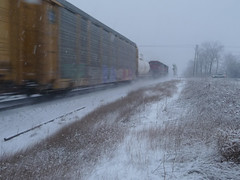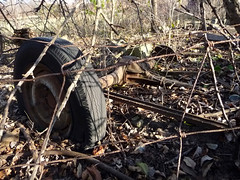
(Click on image to enlarge)
This aerial view, taken in 1938 or '39, shows the area east of Ainsworth, with its 1934 residents marked.
On the morning of December 31, Ed Davis, the young hired hand, showed up at Henry Nolte's farm to help with the morning chores. He found no one stirring, which was odd — Henry was not the type of man to lie abed when the cows needed milking. Ed wandered around to the back of the house. There he noticed a trail of blood over the frozen ground, as if Henry had slaughtered a pig just outside the back porch and then dragged its carcass across the back yard. Out of curiosity, Ed followed the trail to an unfinished cellar entrance. He peered down the incline and saw a crumpled form at its base.
History does not record how young Ed felt when he realized that he was looking at the bloody corpse of Henry Nolte. It records only what he did: he lit out for home to tell his folks. On hearing his story, they telephoned the Hobart police and the Lake County sheriff.
Hobart Police Chief Fred Rose was the first to arrive at the scene of the crime. Soon he was joined by Lake County Sheriff Carroll Holley and his deputies.
They examined the body. Henry had been struck by two shotgun blasts: one in the abdomen, the other in the head — the latter blasting away half his skull. Either shot would have been fatal. The officers found a shotgun, both shells fired, tossed down a cellar stairway. The blood on the ground outside, and the lack of blood anywhere else, evidenced that Henry had been gunned down near his own back porch.
Inside the house, a litter of cigarette butts on the kitchen floor suggested that someone had lain in wait for several hours, smoking to pass the time or steady his nerves. The way the house had been ransacked made the officers think that the killer or killers (they weren't sure how many people had been involved) were familiar with the house — in particular, someone had found and rifled a little hiding-place under a stair-step where Henry kept important papers and, perhaps, cash. And his car was missing from its usual storage spot in the barn.
The investigation spread into the surrounding area. Officers questioned the neighbors, trying to find someone who had seen or heard anything, or who knew of any enemies Henry might have had.
The neighbors were universally shocked by the murder. They may have considered Henry slightly eccentric, for he had never married, and since the death of his younger brother Louis almost two years ago, he had lived completely alone — a bit of an oddity in that time and place. But everyone liked him and respected him as a hard-working farmer and a good manager; his dairy farm was reputed to turn a profit even in the midst of the Depression. Nor did they know of any enemies, or any reason for his having any.
In the course of this questioning, the police came across the child described in the newspaper accounts as the "young Harms boy" — his first name is never given, but based on the 1930 census we can guess that he was Eldon Harms, about 10 years of age. He told police about the incident on the previous afternoon, when he'd been in Mr. Nolte's yard and Richard Chapman had stopped by.
That name set off an alarm bell in Chief Rose's mind. He knew Richard Chapman and had no high opinion of him. Richard had grown up in Hobart as the foster son of Louis and Gertrude Dunham. While still in his teens, he'd served at least two terms in a reformatory for crimes involving mail fraud or the outright robbing of the Hobart post office, or perhaps both. Since leaving his foster parents' home, Richard had drifted around Hobart, Valparaiso and nearby towns, mostly working as a farm hand. The previous summer he had worked on a farm adjoining Henry's. He'd probably heard the rumors that Henry had money.
None of the neighbors had seen Richard since the previous afternoon. He no longer lived in the area. Chief Rose figured he'd better find out where that young man was now.
(To be continued)



















